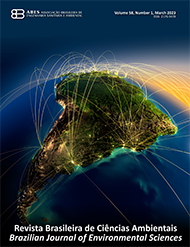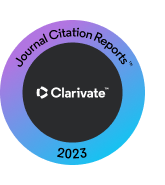Yeast enhancement by mass mating and selective pressure for the integrated production process of first and second-generation ethanol
DOI:
https://doi.org/10.5327/Z2176-94782141Keywords:
biofuel; hybridization; inhibitors; lignocellulosic hydrolysate; tolerance.Abstract
Second-generation ethanol production is a worldwide applicable technology with the potential to replace fossil fuels and contribute to sustainability. The incorporation of second-generation ethanol production in Brazilian biorefineries, besides the technological advantages, adds to the abundance of feedstock derived from the sugar and alcohol industry itself. However, developing yeast strains that resist the inhibitory conditions of the new substrate, potentiated by cellular recycling, is extremely necessary. The aim of the present work was to develop yeast strains by hybridization and selective pressure techniques, with multi-tolerant profile for the fed-batch fermentation process using a mixture of molasses and bagasse hydrolysate as substrate. Therefore, the mass crossing technique was carried out involving five strains of Saccharomyces cerevisiae, previously selected, for demonstrating high tolerance to fermentation from mixed-must composed of lignocellulosic hydrolysate and sugarcane molasses. The culture resulting from the mass mating was followed by a selective pressure during 51 generations, generating enrichment of more tolerant strains. Employing microplate growth evaluation (optical density [DO] 600 nm), ten evolved isolates were selected, which were submitted to lab scale fermentation, simulating industrial conditions to the maximum. In the end, it was possible to highlight a lineage (C8E1-13T) presenting trehalose reserve content significantly higher than the other lineages evaluated, thus demonstrating the generation of an improved phenotype.
Downloads
References
Andrade, R.R; Maugeri Filho, F.; Maciel Filho, R.; da Costa, A.C., 2013. Kinetics of ethanol production from sugarcane bagasse enzymatic hydrolysate concentrated with molasses under cell recycle. Bioresource Technology, v. 130, 351-359. https://doi.org/10.1016/j.biortech.2012.12.045.
Basso, L.C.; Amorim, H.V.; Oliveira, A.J.; Lopes, M.L., 2008. Yeast selection for fuel ethanol production in Brazil. FEMS Yeast Research, v. 8 (7), 1155-1163. https://doi.org/10.1111/j.1567-1364.2008.00428.x.
Bhavana, B.K.; Mudliar, S.N.; Bokade, V.V.; Debnath1, S., 2022. Effect of furfural, acetic acid and 5 hydroxymethylfurfural on yeast growth and xylitol fermentation using Pichia stipitis NCIM 3497. Biomass Conversion and Biorefinery, v. 14, 4909-4923. https://doi.org/10.1007/s13399-022-02758-w.
Blondin, B.; Vézinhet, F., 1988. Identification de souches de levure oenologiques par leur caryotypes obtenus em electrophorese em champ pulse. Revue Française d’Oenologie, v. 28, 7-11.
Carlos, L.; Olitta, T.; Nitsche, S., 2011. Ethanol production in Brazil: the industrial process and its impact on yeast fermentation. In: Bernardes, M.A.S. (Ed.), Biofuel Production-Recent Developments and Prospects. Intech, London, pp. 85-100. https://doi.org/10.5772/17047.
Catallo, M.; Iattici, F.; Randazzo, C.L.; Caggia, C.; Krogerus, K.; Magalhães, F.; Gibson, B.; Solieri. L., 2021. Hybridization of Saccharomyces cerevisiae sourdough strains with cryotolerant Saccharomyces bayanus NBRC1948 as a strategy to increase diversity of strains available for lager beer fermentation. Microorganisms, v. 9 (3), 1-21. https://doi.org/10.3390/microorganisms9030514.
Dionísio, S.R.; Santoro, D.C.J.; Bonan, C.I.D.G.; Soares, L.B.; Biazi, L.E.; Rabelo, L.E.; Ienczak, J.L., 2021. Second-generation ethanol process for integral use of hemicellulosic and cellulosic hydrolysates from diluted sulfuric acid pretreatment of sugarcane bagasse. Fuel, v. 304, 1-9. https://doi.org/10.1016/j.fuel.2021.121290.
Elbakush, A.E.; Güven, D., 2021. Evaluation of ethanol tolerance in relation to intracellular storage compounds of Saccharomyces cerevisiae using FT-IR spectroscopy. Process Biochemistry, v. 101, 266-273. https://doi.org/10.1016/j.procbio.2020.11.028.
Hemansi; Sharma, H.; Patel, A.K.; Saini, J.K.; Singhania, R.R., 2022. Development of multiple inhibitor tolerant yeast via adaptive laboratory evolution for sustainable bioethanol production, Bioresource Technology, v. 344 (4), 126247. https://doi.org/10.1016/j.biortech.2021.126247.
Hou, L., 2010. Improved production of ethanol by novel genome shuffling in Saccharomyces cerevisiae. Applied Biochemistry and Biotechnology, v. 160 (4), 1084-1093. https://doi.org/10.1007/s12010-009-8552-9.
Khan, M.A.H.; Bonifacio, S.; Clowes, J.; Foulds, F.; Holland, R.; Matthews, J.C.; Percival, C.J.; Shallcross, D.E., 2021. Investigation of biofuel as a potential renewable energy source. Atmosphere. MDPI, v. 12, 1-24. https://doi.org/10.339/atmos12101289.
Ko, J.K.; Enkh-Amgalan, T.; Gong, G.; Um, Y.; Lee. S.M., 2020. Improved bioconversion of lignocellulosic biomass by Saccharomyces cerevisiae engineered for tolerance to acetic acid. GCB Bioenergy, v. 12 (1), 90-100. https://doi.org/10.1111/gcbb.12656.
Lairón-Peris, M.; Pérez-Través, L.; Muñiz-Calvo, S.; Guillamón, J.M.; Heras, J.M., Barrio, E.; Querol, A., 2020. Differential contribution of the parental genomes to a S. cerevisiae × S. uvarum hybrid, inferred by phenomic, genomic, and transcriptomic analyses, at different industrial stress conditions. Frontiers in Bioengineering and Biotechnology, v. 8, 1-20. https://doi.org/10.3389/fbioe.2020.00129.
Li, J.; Zhao, R.; Xu, Y.; Wu, X.; Bean, S.R.; Wang, D., 2022. Fuel ethanol production from starchy grain and other crops: an overview on feedstocks, affecting factors, and technical advances. Renewable Energy, v. 188, 223-239. https://doi.org/10.1016/j.renene.2022.02.038.
Lindegren, C.C.; Lindegren, G., 1943. A new method for hybridizing yeast. Proceedings of the National Academy of Sciences of the United States of America, v. 29 (10), 306-308. https://doi.org/10.1073/pnas.29.10.306.
Mans, R.; Daran, J.M.G.; Pronk, J.T., 2018. Under pressure: evolutionary engineering of yeast strains for improved performance in fuels and chemicals production. Current Opinion in Biotechnology, v. 50, 47-56. https://doi.org/10.1016/j.copbio.2017.10.011.
Lopes, M.L., 2000. Estudo do polimorfismo cromossômico em levedura selecionada do processo industrial de produção de etanol. Doctoral Thesis, Instituto de Biociências, Universidade Estadual Paulista, Rio Claro, São Paulo. Retrieved 2023-12-08, from www.unesp.br
Lopes, M.L.; de Lima Paulillo, S.C.; Cherubin, R.A.; Godoy, A.; Amorim Neto, H.B.; Amorim, H.V., 2015. Tailored yeast strains for ethanol production: the process driven selection. Fermentec, Piracicaba, 42 p.
Moonsamy, T.A.; Mandegari, M.; Farzad, S.; Görgens, J.F., 2022. A new insight into integrated first and second-generation bioethanol production from sugarcane. Industrial Crops and Products, v. 188, 1-13. https://doi.org/10.1016/j.indcrop.2022.115675.
Muynarsk, E.S.M.; Christofoleti-Furlan, R.M.; Dias do Prado, C.; Sthepani, B.O.C.; Vidal, D.C.O.; Basso, T.O.; Cunha, A.F.; Basso, L.C., 2023. Selection and improvement of Saccharomyces cerevisiae by direct and mass mating for integrated first and second generation (1G + 2G) ethanol production. Biocatalysis and Agricultural Biotechnology, v. 53, 102865. https://doi.org/10.1016/j.bcab.2023.102865.
Oliveira, A.J.; Gallo, C.R.; Alcarde, V.E.; Godoy, A.; Amorim, H.V., 1996. Métodos para o controle microbiológico na produção de álcool e açúcar. FERMENTEC/FEALQ/ESALQ-USP, Piracicaba, 89 p.
Naseeb, S.; Visinoni, F.; Hu, Y.; Roberts, A.J.H.; Maslowska, A.; Walsh, T.; Smart, K.A.; Louis, E.J.; Delneri. D., 2021. Restoring fertility in yeast hybrids: breeding and quantitative genetics of beneficial traits. Proceedings of the National Academy of Sciences, v. 118 (38), 1-12. https://doi.org/10.1073/pnas.2101242118/-/DCSupplemental.
Neitzel, T.; Lima, C.L.; Biazi, L.E.; Collograi, K.C.; Costa, A.C.; Santos, L.V.; Ienczak, J.L., 2020. Impact of the melle-boinot process on the enhancement of second-generation ethanol production by Spathaspora passalidarum. Renewable Energy, v. 160 ,1206-1216. https://doi.org/10.1016/j.renene.2020.07.027.
Péter, M.; Gudmann, P.; Kóta, Z.; Török, Z.; Vígh, L.; Glatz, A.; Balogh, G., 2021. Lipids and trehalose actively cooperate in heat stress management of Schizosaccharomyces pombe. International Journal of Molecular Sciences, v. 22, 13272. https://doi.org/10.3390/ijms222413272.
Pinel, D.; D’Aoust, F.; del Cardayre, S.B.; Bajwa, P.K.; Lee, H.; Martin, V.J.J., 2011. Saccharomyces cerevisiae genome shuffling through recursive population mating leads to improved tolerance to spent sulfite liquor. Applied and Environmental Microbiology, v. 77 (14), 4736-4743. https://doi.org/10.1128/AEM.02769-10.
Phillips, E., 2022. Nanotechnological interventions in biofuel production. In: Sahay, S. (Ed.), Handbook of Biofuels Academic Press. Biofuels Academic Press, Cambridge, MA, pp. 593-604.
Qi, L.; Zhu, Y.; Wang, Y.; Tang, X.; Li, K.; He, M.; Sui, Y.; Wang, P.; Zheng, D.; Zhang, K., 2023. Nonlethal furfural exposure causes genomic alterations and adaptability evolution in Saccharomyces cerevisiae. Microbiology Spectrum, v. 11 (4), https://doi.org/10.1128/ spectrum.01216-23.
Santos, R.M.; Nogueira, F.C.S.; Brasil, A.A.; Carvalho, P.C.; Leprevost, F.V.; Domont, G.B.; Eleutherio, E.C.A., 2017. Quantitative proteomic analysis of the Saccharomyces cerevisiae industrial strains CAT-1 and PE-2. Journal of Proteomics, v. 151, 114-121. https://doi.org/10.1016/j.jprot.2016.08.020.
Steensels, J.; Snoek, T.; Meersman, E.; Nicolino, M.P.; Voordeckers, K.; Verstrepen, K.J., 2014. Improving industrial yeast strains: exploiting natural and artificial diversity. FEMS Microbiology Reviews, v. 38 (5), 947-995. https://doi.org/10.1111/1574-6976.12073.
Tahara, E.B.; Cunha, F.M.; Basso, T.O.; Della Bianca, B.E.; Gombert, A.K.; Kowaltowski, A.J., 2013. Calorie restriction hysteretically primes aging saccharomyces cerevisiae toward more effective oxidative metabolism. PLOS One, v. 8 (2), 1-11. https://doi.org/10.1371/journal.pone.0056388.
Tomova, A.; Kujumdzieva, A.V.; Petrova, V.Y., 2019. Carbon source influences Saccharomyces cerevisiae yeast cell survival strategies: quiescence or sporulation. Biotechnology and Biotechnological Equipment, v. 33 (1), 1464-1470. https://doi.org/10.1080/13102818.2019.1674188.
Treco, D.A.; Winston, F., 2008. Growth and manipulation of yeast. Current Protocols in Molecular Biology, Chapter 13, Unit13.2. https://doi.org/10.1002/0471142727.mb1302s82.
Trevelyan, W.E.; Harrison, J.S., 1956. Studies on yeast metabolism. 5. The trehalose content of baker’s yeast during anaerobic fermentation. Biochemical Journal, v. 62, 177-183. https://doi.org/10.1042/bj0620177b.
Yao1, L.; Jia1, J.; Zhang1, O.; Zheng1, X.; Yang, H.; Dai1, J.; Chen1, X., 2024. Adaptive laboratory evolution to obtain furfural tolerant Saccharomyces cerevisiae for bioethanol production and the underlying mechanism. Frontiers in Microbiology, v. 14, 1-11. https://10,3389/fmicb.2023.1333777.
Zago, E.A.; Amorim, H.V.; Basso, L.C., 1989. Métodos Analíticos para o Controle da Produção de Álcool. Fermentec/CEBTEC/ESALQ/USP, Piracicaba, 144 p.
Zimmermann, M.; Fournier, P., 1996. Electrophoretic karyotyping of yeasts. In: Wolf, K. (Eds)., Non-conventional yeasts in biotechnology. Springer, pp. 101-116. https://doi.org/10.1007/978-3-642-79856-6_3.
Published
How to Cite
Issue
Section
License
Copyright (c) 2024 Revista Brasileira de Ciências Ambientais

This work is licensed under a Creative Commons Attribution 4.0 International License.


























